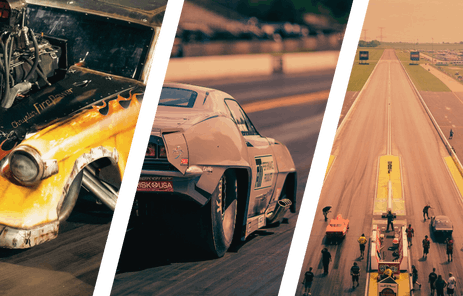We know that the most critical elements in a car’s drivetrain is the driveshaft—it’s the weakest link –as exemplified by many tales of on-track incidents where a car chucks its driveshaft, or it is twisted into looking like a pretzel. Broken driveshafts can also lead to severe engine damage from over-revving.
Whether you’re driving a five-second Pro Mod car or a bracket car, getting power to the ground is obviously important. But while some may consider getting the biggest and beefiest driveshaft available, “overkill” can be a factor. Having a lighter driveshaft can pay dividends in performance by reducing rotating mass.
Driveshaft Materials
As there are a myriad of factors to contend with in choosing what’s best for your application and budget, we turned to Travis Podratz, a senior tech rep at Mark Williams Enterprises —the highly respected Colorado-based manufacturer of driveline components. On a daily basis, Travis deals with a wide spectrum of customers that range from elite chassis builders to DIY amateurs.
According to Podratz, the most common question relates to what material to use. This boils down to the optimum shaft for the application and budget. The least expensive driveshafts are made from mild steel. Stepping up to a more expensive alloy, 4130 chromoly gives you added strength and allows for a thinner wall thickness, thus saving weight.
Aluminum is lighter yet, with many manufacturers offering 6061 alloy shafts. Additionally, Mark Williams Enterprises exclusively offers driveshafts made of 7075 alloy aluminum, which is some 30% stronger than 6061 and allows the shafts to have thinner walls and save weight. At the top end of the scale, we have carbon fiber, which is the lightest and has the best critical speed…but also the most expensive. Years ago, titanium was tried, but its prohibitive cost compared to any advantages saw it lose favor in the marketplace.
Essentially, there are five parameters to consider: shaft material (and its relative strength), shaft diameter, wall thickness, overall length, and U-joint type. A key factor in deciding what to run is the driveshaft’s inherent critical speed — the point at which any rotating shaft becomes unstable and can create vibration of sufficient amplitude to cause destruction. In essence, the shaft will go into “jump rope” mode and shake to the point of failure. There are three factors that determine a shaft’s critical speed: length, diameter, and the ratio of weight to material stiffness. There’s a comprehensive chart on Mark Williams Enterprises’ website and in their catalog.
Driveshaft Size, SFI Specifications, And More
Of course, the weight of the vehicle must be considered. The stress placed on a driveshaft while trying to launch a heavy full-framed car is much greater than for a lighter tube-chassied race car.
There is yet another consideration in choosing a driveshaft for your race car, SFI 43.1 specifications. Most racing associations mandate that really fast cars, like Pro Mod and Pro Stock, are equipped with driveshafts that meet SFI 43.1 specs. Other driveline components, like clutches, flywheels, flexplates, and transmission cases, are also subject to SFI certification. The obvious goal here is to maximize racer safety.

SFI’s test procedures include applying a 2,500-pound load, reversing it to 1,000-pounds, and performing 25 such cycles at a rate of at least 3-5 cycles per minute. Any torsional angular deformation of the shaft is subject to certification disqualification (so are signs of buckling or cracks). Whichever class of car you run, you can be assured that an SFI 43.1-certified driveshaft will serve you well.
Another factor to consider is the weight of the driveshaft, since there are performance benefits to reducing the rotating mass, as well as overall car weight. For the sake of comparison, a steel 3.5-inch o.d. driveshaft (with an M-W Turbo 400 yoke) tips the scale at 20.6-pounds. A similar-sized driveshaft made of 7075 aluminum weighs only 13.7-pounds. Therefore, it will take less power to accelerate the driveshaft to operating RPM, with that savings going to propelling the vehicle.

This brings us to the assembly process, where it’s important that the U-joints are properly phased. Mark Williams Enterprises employs fixtures to ensure this. While steel driveshafts are welded, Mark Williams Enterprises relies on a patented chemical process called “Accu-bonding” for its aluminum and carbon fiber shafts. It’s been quantified to be superior to welding through extensive analysis on Mark Williams Enterprises’ unique Torsional Testing Device. The last operation is balancing. Each shaft — with the actual yokes to be employed — is tested at operational parameters and must meet or exceed G30 specifications to assure smooth operation.

When it comes to U-joints, Mark Williams Enterprises and other manufacturers rely on heavy-duty 1350 U-joints in favor of the smaller OEM-sized joints. For high horsepower applications, beefier 1480-series U-joints are recommended.
When asked about measuring for a new driveshaft, Podratz replied, “Make sure the wheelbase and ride height are set, and the rearend housing is positioned with the correct pinion angle. Years ago, it was common to point the pinion down — but that only applied to cars with leaf spring rear suspension as a compensation for spring ‘wrap.’ Today’s four-link and ladder bar cars don’t have that problem. You’ll also need to make sure you have proper clearances as the suspension articulates.”
So there you have it. When you have a quality “bulletproof” driveshaft you can depend on, you can focus on getting optimum power to the ground and winning races.
Editor’s note: the author is employed by Mark Williams in some capacity, however, we felt this article provided sufficient value to our readers and did not make any unreasonable claims or otherwise prove a conflict of interest.
You might also like
History Restored Bob Riffle's 1973 Dodge Dart
Bob Riffle's 1973 Dodge Dart was an iconic race car in the 1970s. The Dart recently was fully restored to its original state.








